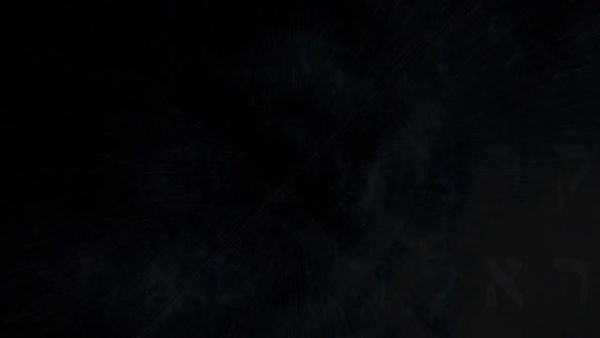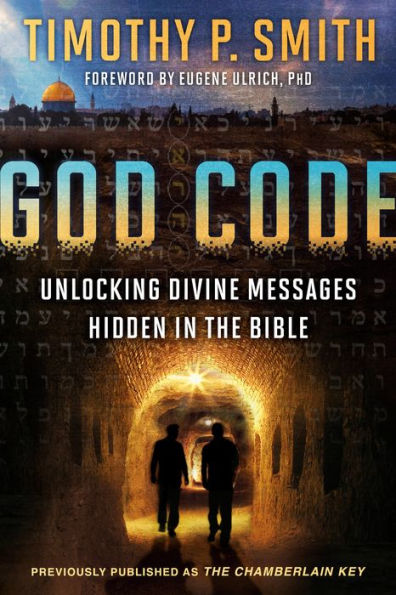
God Code: Unlocking Divine Messages Hidden in the Bible
224
God Code: Unlocking Divine Messages Hidden in the Bible
224eBook
Related collections and offers
Overview
The book that inspired the major History Channel special God Code shows there is more to the Bible than meets the eye—messages from God hidden for ages, now revealed by modern computer technology.
In God Code, antiquities expert Timothy P. Smith reveals his decades-long quest to understand the complex messages he discovered in an ancient Hebrew manuscript of the Bible. This painstaking search involves adventure and mystery, but instead of consulting ancient maps to find buried treasure, Smith relied on the data calculation power of modern technology. His quest shows how Scripture is more amazing than we ever dreamed—and that it may even reveal the future of generations living today.
God Code reveals:
• An encrypted code in Genesis, in the oldest known Hebrew text of the Old Testament, that predicted the birth and resurrection of Jesus.
• Scientific evidence that this encrypted code was authored by the divine hand of God.
• Signs that there are more encrypted codes in this same Hebrew text that will lead to additional messages from God to humanity.
• Hidden clues that may lead to the location of long-missing sacred artifacts, such as the Ark of the Covenant.
• Insights on why Smith was chosen to uncover this encrypted code.
• A dire warning that God wants us to hear—and heed.
In the companion History Channel series, the author travels across continents in search of artifacts missing since Bible times—clues to their location revealed in God Code.
Previously published as The Chamberlain Key

Product Details
| ISBN-13: | 9781601429162 |
|---|---|
| Publisher: | Random House Publishing Group |
| Publication date: | 04/04/2017 |
| Sold by: | Random House |
| Format: | eBook |
| Pages: | 224 |
| Sales rank: | 980,444 |
| File size: | 25 MB |
| Note: | This product may take a few minutes to download. |
About the Author
Bob Hostetler is the award-winning author of more than thirty books, including American Idols and the historical novel Northkill. His books have sold over three million copies.
Read an Excerpt
FOREWORD
As chief editor of the biblical Dead Sea Scrolls, I have spent my entire career teaching and writing in the areas of the Hebrew Scriptures, the scrolls, and the Septuagint. With regard to the reliability of the Masoretic Hebrew text that is used in the observations made in this book, it is based on the Saint Petersburg Codex (Codex Lenin- gradensis; Firkovich B 19 A), which is the oldest complete manuscript of the Hebrew Bible in the Hebrew language, whose colophon dates it to AD 1008 or 1009. This is the text, in modern printed form (Biblia Hebraica Stuttgartensia), used by most scholars today.
The Aleppo Codex is almost a century older, but most of the Pentateuch is miss- ing from it. The Dead Sea Scrolls are older by a millennium, but, though fragments from almost thirty manuscripts containing parts of Genesis are preserved, none contains text from Genesis 30.
The antiquity of that Hebrew tradition is safely assured, however, by three different sources. First, the Dead Sea Scrolls in the Genesis fragments that did survive exhibit a text that is virtually identical with the Saint Petersburg Codex. Second, the (pre-Christian) Samaritan Pentateuch is identical with it in its consonantal text. Third, the ancient Greek translation (the Septuagint) of Genesis, most scholars would agree, was translated around 280 BC from a Hebrew source text that was virtually identical with the Hebrew consonantal text of the Leningrad Codex.
However one wishes to interpret the meaning and significance of this book, the reader may rest assured that the text on which Timothy Smith bases his interpretation has almost certainly been there for a very long time, since before the birth of Christ.
—Eugene Ulrich, PhD Chief Editor, Biblical Dead Sea Scrolls
Department of Theology, University of Notre Dame
Out of the Shadows
For more than fifteen years I managed to keep the lid on a discovery that will dramatically redirect biblical scholarship, Christian theology, and perhaps even the trajectory of history itself.
What began as a mystery concerning my own family and ancestry has unfolded into perhaps the most astounding revelation of the modern age, as you will see in the pages that follow. It is based on an unexplained phenomenon, an anomaly in four verses of text in the oldest complete manuscript of the Hebrew book of Genesis. I have found messages embedded in those few verses that simply could not be there— but nevertheless they were.
I have pursued every possible explanation in an effort to account for this bizarre finding. One discovery has led to another and then another. I’ve consulted some of the world’s most respected scholars and scientists until only one plausible explanation remains: the original ancient text of the Hebrew Scriptures (parts of which date back to 800 BC, perhaps earlier) is more than a text in the traditional sense—more than a manuscript containing wisdom and prophecy and transcendent truth. It is also a complex communication device with the ability to breach the very boundaries of time itself. By using this tool, a supernatural power has reached across millenniums to make contact with you and me, right here and now.
The text of the Hebrew Bible presents us with a familiar literary structure. Words form sentences and concepts that we recognize. We use accepted rules of translation and interpretation to extract what we believe is the meaning of the narrative. However, the smallest discrete units of the biblical text are Hebrew letters, the quanta of this textual universe, which are capable of organizing themselves into a less obvious form of intelligent communication, one that transcends the ordinary parameters of time and space. This hidden substructure is what holds the ancient He- brew text together.
The key that I’ve found to this hidden language is not some rigid, mechanical cipher code but a means of gaining access to the beautifully unpredictable nature of the universe and life itself, which turns out to possess a level of order that is both intentional and intelligent. A manifestation of divine intelligence—or God, if you will—is functioning in visible ways right alongside us.
And now we have a new way to access it.
It is no easy task to explain how I made this discovery, let alone to help you understand and believe it. After all, I am neither a scholar nor a theologian. Neither am I an expert in ancient languages. In some ways I am a most unlikely candidate to have uncovered signs of a divine hand at work, which sometimes has left me wondering, Why me? and Why now?
I hope the account you are about to read will answer those questions while also serving to strengthen your faith, as it has mine.
Part I
THE UNFOLDING
1 Finder of Lost and Hidden Things
Virginia, 2016
The chamberlain key was not my first discovery in a life marked by curiosity and exploration. But it is by far the most important and consequential.
For more than thirty years I have engaged in the work of evaluating and preserving valuable physical objects from every part of the world and every period in history. I have spent most of my life answering questions and unraveling mysteries, many of which began with something I could touch: a chest, a painting, a tapestry, a scepter, a banner, a coin, a cloak, a sword, or a scroll. As an appraiser, restorer, and conservator of fine art and antiquities, I have discovered priceless items stashed in attic eaves, sealed in long-forgotten vaults, or gone missing from the White House. Many such treasures have impressed me with their astronomical value, dazzled me with their breathtaking beauty, or haunted me with their gruesome history. But like many explorers, historians, and investigators, I have passed much of my time in the unglamorous drudgery of countless details, the disconnected bits of things that must be carefully considered, culled, and reassembled before the destination is reached or the truth uncovered.
My paternal grandfather, Clarence R. Smith, arrived in Washington, DC, in 1938 to begin the construction of the Jefferson Memorial. He also worked on a number of other important building and renovation projects: the National Gallery of Art, the US Capitol, the Carderock Division of the Naval Sea Systems Command, and many others. His youngest son—my father, E. Jay Smith—continued in this tradition, be- ginning with the construction of the official residence of the vice president on the grounds of the US Naval Observatory. When my father retired in the 1990s, his building and architectural firm was credited with designing, building, and renovating many of the Washington area’s most venerated public buildings and private residences.
I was born in 1960 in Langley, Virginia, a tiny community just inside the Washington, DC, Beltway. In 1966 my parents purchased a small horse farm in Great Falls, Virginia, a mere seven miles up the Potomac from Langley. The place was called Windswept, and all the horses had been named accordingly: Gusty, Breezy, Sea Breeze, and so on. The brick ranch house rambled along the side of a steep hill overlooking rolling pastures and a lake fed by a stream known as Colvin Run. The property was adjoined on all sides by other horse farms and small Virginia estates.
Among my favorite activities on a cold, rainy day was to sneak into our home’s spacious attic and pull up the ladder behind me so no one would know I was there. I listened to the muffled sound of voices and footsteps below, delighted by the musty secrecy of the place, as I rummaged through boxes of old photographs, sports equipment, toys, tools, and Christmas decorations. I set up the family nativity scene, placing a small candle in the stable, positioning and repositioning animals and people until I was satisfied that all were in their correct spots.
One stormy day in late winter I could no longer resist the sturdy pine boxes stacked against the eaves in the far corner of the attic. I knew perfectly well they were forbidden, but their lure was overpowering. By the light of a red Christmas candle I carefully slid the top crates onto the attic floor, opened them one by one, and inspected their contents. There were folders full of old handwritten documents, their pages creased and oxidized to a light tobacco brown. One box contained nothing but ornate knobs, handles, and latches—some of rich patinated brass and others of skill- fully handwrought iron, pitted and rusted but still intact. Another was crammed with metal tubes containing rolled-up architectural drawings and wonderful hand- colored maps that I turned in every direction, attempting to decipher their locations in the larger world.
Most curious of all was a large iron star, cast in round relief, its dry soldier-blue paint flaking off onto my hands as I dragged it into the candlelight for a better look. I hefted it above my head and figured it weighed more than half a sack of sweet feed, about thirty-five pounds. I had no idea at the time where it had come from and what its purpose might have been. Only later would I learn that it was originally part of a set of thirteen, one star for each of the original American colonies.
I would also discover that twenty years before, at the end of World War II, my grandfather had begun one of many renovation projects on the US Capitol building, this time to replace the ceilings and roofs of both the House and Senate chambers. The star I’d found in the attic once hung in the Capitol but had since become part of a forgotten treasure trove of historic documents and artifacts in that structure’s attics and catacombs. As the only star among its companions that was ever salvaged and retrieved, in some ways it illuminated the course of my professional life and personal passion. Years later, when I became a professional hunter and finder and restorer of lost and forgotten things, I arranged for the star to be returned to the architect of the Capitol.
A TREASURE HUNTER’s TRAINING
On the first day of my summer vacation from school in 1972, my dad came into my bedroom at 5:30 a.m. and placed a leather tool belt, fully equipped, at the foot of my bed and told me it was time to get up and get going. This was not a total surprise, since all three of my older brothers had their summer vacations commandeered in the same way. I spent my first day “on the job” at the equipment and material yard, where I worked in the blazing sun, prying nails out of old lumber so it could be re- claimed for concrete forms, scaffold boards, and gangways. My supervisor, Lonnie, was a tough, weathered African American man who had worked for my father since my father first went into business and with my grandfather before that. Under his watchful eye I hauled bricks, mortar, lumber, and shingles from one spot to another and occasionally swung my hammer at wide-headed roofing nails that Lonnie must have figured were hard to miss.
Toward the end of that summer, a plan began to shape itself in me. I recognized that it wasn’t the buildings themselves that interested me, despite their magnificence; it was the things we often found in them. Some of the workmen, including my older family members, spoke of finding old and curious items in strange places, and I began to wonder if a job existed where a person could be paid to locate lost or hidden objects, a sort of professional finder of things.
By the time I was twenty years old, I owned and operated a thriving antique- restoration operation out of the family-business headquarters in McLean, Virginia. Capitalizing on the reputations of my father and grandfather, I was invited into homes and institutions that were pretty heady for someone my age. I hired the most talented and dependable subcontractors in the area: oil-painting conservationists trained at the Royal Academy of Arts in London, porcelain specialists from China, cabinet and furniture makers moonlighting from their jobs with my father, and a furniture upholsterer who had worked for every First Lady since Bess Truman. I ferried the more common items to a workshop I maintained in the Shenandoah Valley. I plied every- one I encountered for information, techniques, and trade secrets, learning how to handle many projects myself. I trained others from scratch to handle the nuts-and- bolts repair jobs, and I developed protocols and habits that serve me well to this day.
Not long after setting up my own shop, I was invited to perhaps the most historic estate home in the McLean area. Known as Salona, it had been the home of Henry “Light Horse Harry” Lee, the Revolutionary War hero and father of Gen. Robert E. Lee. The current owner was a distinguished elderly woman, matriarch of a prominent Mid-Atlantic political family. We had never met, but she contacted me because she knew my parents socially and because my father’s company had been involved in the architectural renovation of Salona House.
When she greeted me at the door, I got the impression that she mistook me for my oldest brother (I sported a closely trimmed beard at the time and looked older than my twenty years). As she led me on a grand tour of the historic home, it was obvious she had played the docent many times before.
My hostess began by describing a pre-Columbian settlement on the site and showed me a small collection of Native American artifacts that had been unearthed on the property over the years. She led me from room to room, recounting well- rehearsed facts and anecdotes about the furnishings and architectural details of the estate home. Nearly every piece of English and Early American furniture had a story that was interwoven with important events in Virginia history and the many prominent figures in her family. She identified the subject of every portrait on the walls and drew my attention to antique Persian carpets, rare Chinese Imperial and imported porcelains, delicate English Staffordshire pieces, and sturdy mocha-ware pottery. She concluded her private seminar with a romantic (and historically accurate) account of how Dolley Madison fled to the refuge of Salona in 1814 when British troops were burning the White House in order to reunite with her husband, President James Madison, who had arrived the previous day.
Having completed the tour, we reversed our course back through the house as my hostess pointed out various furnishings, artwork, and other items I would be asked to clean, repair, and restore. She never requested a cost estimate, only a time- line for completing the work. Though at the time I was in over my head, I took great pains with those valuable articles and learned all I could about them while they were in my care: the precise materials used in their composition, the methods applied to their construction, individual variations and subtleties of style and proportion, as well as the identity and background of their makers. I consulted with seasoned experts to be sure I didn’t embark on any process that might depreciate the pieces in any way. I was especially keen to note signs of previous restoration and repair, to avoid the less-than-perfect work of my predecessors in the trade, and to emulate their most artful successes.
That was a seminal experience for me. The care and effort I invested in Salona House soon brought more opportunities, and I gave every new assignment as much attention as I had the first, along with the benefit of my growing expertise. I made it my goal to turn up some new tidbit of information that I could offer every client when the job was finished and their precious objects returned. My patrons appreciated my interest and enthusiasm, and they rewarded me with referrals that led to a constant stream of fascinating employment.
By the time I was twenty-six years old, I was operating one of the largest antique and fine-art restoration businesses in North America, with one division devoted to private clients and another to contracts with the federal government.
But the clues to the greatest treasure I would ever discover were still hidden in my dreams.
STORMS AND SYMBOLS
My life on the surface no doubt looked great to outsiders, but my inside life was a different story. I was experiencing a crisis of faith. Although my family, church, and business responsibilities were expanding and thriving, my spiritual strength seemed to be draining away. Was I buckling under my new responsibilities? Was I burning out? Cracking up?
My dreams were contributing to my stress. On the exact same date for three years in a row—beginning on the night of January 12, 1986—I’d had the same powerful dream. I know because I started keeping a journal the morning after the first one, a practice I have continued ever since.
Each dream began the same way, with a massive dark storm rising ominously on the horizon, but the dream each year extended the story and contributed new details. These dramatic scenes employed distinct symbols, some of which were familiar to me and some of which were entirely new. After each dream I dug into Scripture and history to try to decipher its meaning.
Then one night in April 1989 I had another dream, this one out of sequence and very different from the rest, a dream in which I was looking at a map of North America. I saw a tiny cartoon version of our Ford van driving from east to west across the continent, much like a 1940s newsreel showing a plane flying across a spinning globe. In the dream our van stopped deep in the Canadian Rockies of British Columbia. The location imprinted itself so vividly in my brain that when I awoke I was able to pull out an atlas and mark the spot. I noted the longitude and latitude, wrote them down on a scrap of paper, and put it in my wallet.
I believed, because of the repetitive nature of the dreams and some of the symbolic nature of the content, that I was being guided—and prompted to act—though for what purpose I didn’t have a clue. Thanks to the dream, however, I did have one strikingly specific detail: a place I could locate.
Plunging ahead with the reckless confidence—and often the foolishness —of youth, I decided to go there.
Table of Contents
Foreword Eugene Ulrich vii
Introduction: Out of the Shadows 1
Part I The Unfolding
1 Finder of Lost and Hidden Things 5
2 An Overwhelming Encounter 11
3 Awakening Awareness 20
4 The Chamberlain Key 29
Part II Under Scrutiny
5 A Door Opens 43
6 The Key Code 53
7 Who Are You? 66
8 Crossing the Delaware 73
9 What's Going On? 82
10 An Unlikely Candidate 91
Part III Mysterious Madonna
11 The Matrix Turns 101
12 The Plot Widens 113
Part IV Signs and Warnings
13 Led Every Step of the Way 133
14 Do Not Hide the Truth 145
15 For Such a Time as This 154
16 Actionable Intelligence 166
Postscript: Things to Come 172
Acknowledgments 181
Appendix: Decoding Methods 183
Notes 187
Glossary 195
Recommended Reading 207
Index 209
Related Subjects
Videos




